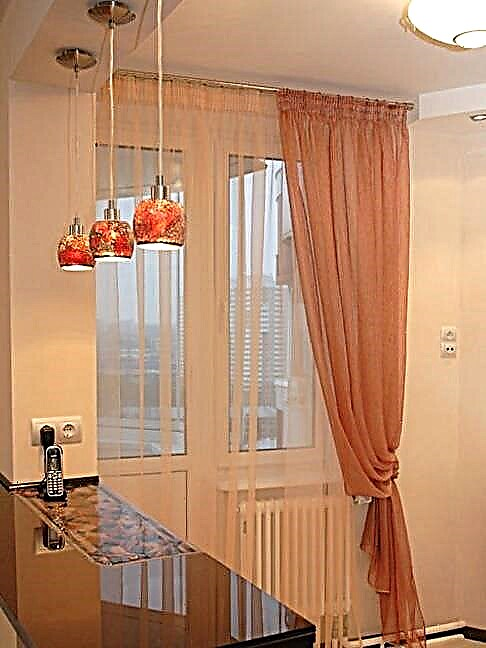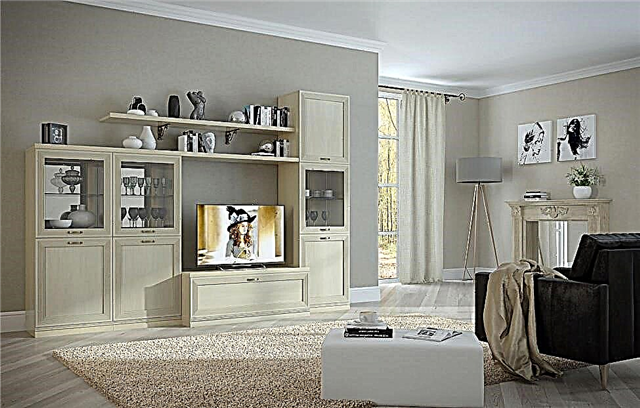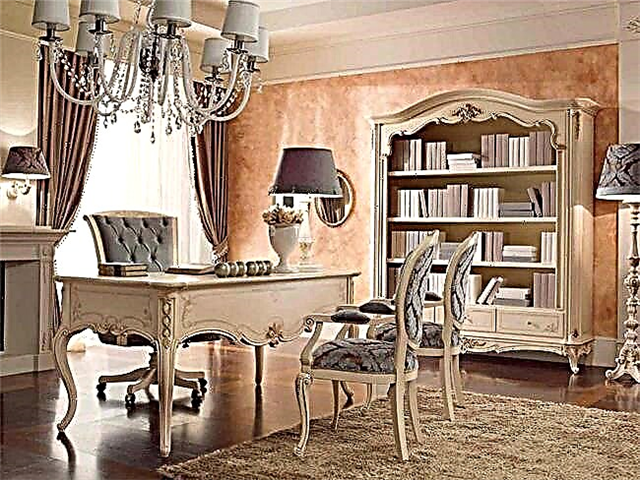
join the discussion
Share with your friends
Every day, our eyes are fixed on the TV, so its location and design should be given special attention. About how to harmoniously fit the TV zone into the interior, our article will tell.
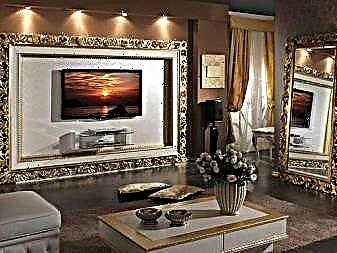

TV placement options
It is better to position the TV at the optimum distance from the sofa. Height is also determined based on the convenience of the audience. The television receiver should not hang too high. You should not put it on a very low stand. The choice of diagonal depends on the dimensions of the room.
In a small room, a medium-sized model mounted on a wall or ceiling will look better. In the spacious hall you can place bulky equipment. Usually, for the TV zone, choose the side opposite the window or perpendicular to it.
If you decide to put the TV in the same place where the window is, you should take care of buying dense roller blinds or blinds. Otherwise, sunlight will interfere with viewing.
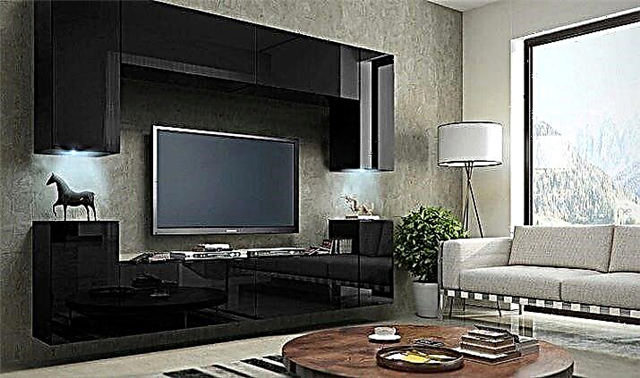
In general, there are several options for placing a TV.
- On the wall. The easiest option is to attach it to the wall.
- In the corner. Sometimes angular placement is the best solution. This technique helps to save space in a small space and gives more room for the implementation of design ideas.
- In a niche. If the layout includes a niche, the TV will fit perfectly into it.
- In drywall. The construction of drywall with a niche corresponding to the size of the TV allows you to create the effect of built-in technology.
- On a nightstand. If you have chosen a model on a stand, you can place it on the bedside table.
- In the center of the room. If the hall is very large, it is not advisable to place a sofa and a TV at opposite walls - the distance will be too large. If you do not want to clutter up the center of the room with upholstered furniture, you can build a mini-partition from plasterboard and place the TV receiver on it.
- On a large partition. If a large partition has been built in the studio apartment separating the cooking and resting areas, you can use it for the TV zone.
- On the ceiling. Ceiling mount can be very convenient. This eliminates the need to allocate a special place for the TV. In addition, this solution looks pretty elegant. The device hangs freely in the air and can be rotated in any direction.
- In the furniture complex. Many modern walls and racks provide space for a TV zone. This is very convenient, since there is no need to think through the nuances of designing the location of the equipment. It turns out a harmonious and attractive composition.
- Above the fireplace. Fire calms, pacifies, creates a cosiness. If you are sure that the dancing flame will not distract from the screen, you can hang the TV over the fireplace. The main thing is to maintain compliance with the sizes. Both elements should have approximately the same dimensions.
- Disguise. Sometimes, for some reason, the owners want to hide the TV. You can do this by hiding it behind the retractable door.
Where to place?
When designing the living room, you need to determine the location of the TV. Of particular importance is the area of the room. In a compact living room, hanging a large plasma panel on the wall will be irrational for the simple reason that the size of the room will not allow you to comfortably sit for viewing. The optimal viewing distance is one that is equal to two device diagonals. Small living rooms will not be able to satisfy this requirement.
Layout also plays a role. Better hang the TV on a long wall. It gives more opportunities for decoration, allows you to realize different ideas and harmoniously fit the device into the interior of the hall. At the same time, a TV will look appropriate on such a plane, drawing attention to itself from long walls, visually changing the space of the room.
When choosing a place for a TV, you need to consider the fact that it should be located at some distance from the floor (just below the eye level of a seated person). When calculating at what height it is better to install a TV, you need to consider the height of the furniture. It is especially important if it will be located on a long pedestal. The main criterion for choosing the location of the TV is the degree of convenience. The picture should be well visible from any angle (from any part of the room).
It is necessary to take into account the proximity of all kinds of lamps, floor lamps, heating elements. This fireplace should be located at a considerable distance from the TV. The heat generated by the appliances can negatively affect the TV.
Mounting
Having correctly chosen the location of the TV, you can take on its fasteners. In this case, you need to follow some rules:
- Before perforating the wall, make sure that the wiring does not pass in the selected place, that there are no wires,
- it is important to leave free space on the sides, behind the TV, to ensure air circulation and protect the device from overheating,
- you must hide all the wires.
You cannot mount a TV on a drywall. Lightweight material will not support the weight of the product in 25-35 kg. It is better to mount the TV on a brick or concrete wall. If there is no other way out, and you have to mount it on drywall, before installing it you need to strengthen it with the help of boards or dense plywood.
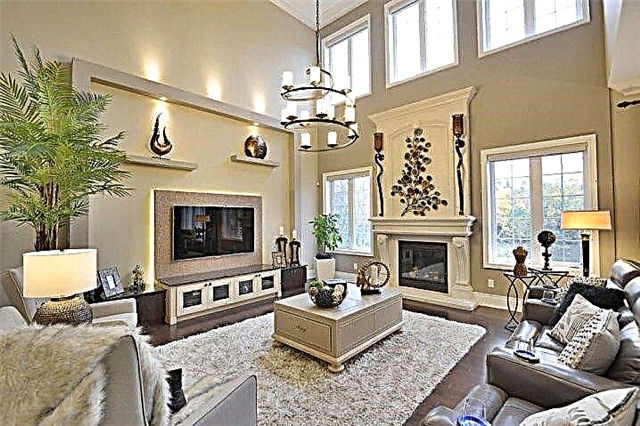
Mounting Options
The TV is mounted in two ways - using the support or bracket. A support is a part that secures the monitor to a metal strip. It can be ordered at the factory or made independently. An arm is a structure on which a screen is fixed. He might be:
- rigid (the monitor is strictly fixed and cannot change the angle)
- inclined (allows you to tilt the screen 20 degrees from the base),
- tilt-swivel (the screen can be rotated and tilted in different directions).
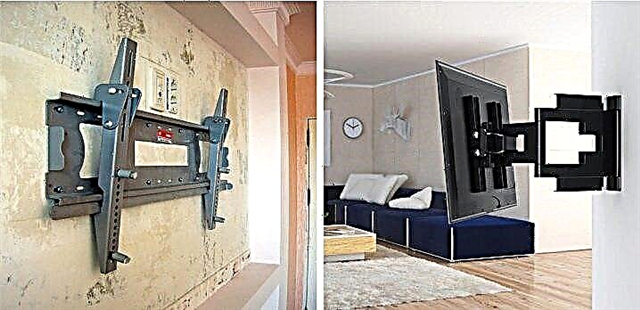
The next step is decorating the wall.
Wall decoration
Before starting work, you need to consider:
- color of wall decoration material,
- the invoice of the material used,
- the degree of visual convenience of the location of the equipment on the selected wall,
- possible factors affecting the TV (for example, glare from mirror and glossy surfaces).
It is necessary to find out how much space the screen will occupy, whether the selected model will turn out to be too large. To do this, you need to sketch the future design of the wall, having worked through all the options.
The choice of colors depends on the overall palette of the living room. For example, in a room decorated in light pastel colors, the TV will be perceived as a black spot, which is completely inappropriate in this interior. In completely dark interiors, it can get lost, merge with the surroundings. In certain cases, it’s even good (for example, in a classic interior it is better to hide such pronounced elements so that they do not violate the integrity of the composition).
In the case of modern styles (hi-tech, minimalism, loft), the TV should harmoniously fit into the interior, emphasizing its individuality.
There are several ways to do this.
Using different materials
This can be contrasting wallpaper, highlighting exactly that part of the wall on which the TV is placed, murals, wallpapers with a 3D effect, glued to the entire wall. Partial painting of the wall (the space around the TV) is appropriate, highlighting it using plaster, bamboo canvas, textile elements, brick or stone finishes.

Use special designs
It can be niches, racks, shelves, modular furniture, wall panels. Their parameters depend on the TV model. Furniture is selected so that the shade is contrasting. Niches are finished to match the main wall, or glued with self-adhesive, painted.
Highlighting with decorative elements
For this technique, you can use vinyl stickers, frames, mirrors. However, you need to consider that any decor attracts attention, even if its size is small. It is more advisable to put a figurine near the TV than a large mirror that can compete with TV.
If the room is small and performs several functions at once (for example, it is a living room and a bedroom or a living room and an office), the best solution is to use furniture in which there is a place for TV. Most often it is located in the center of a rectangle formed by shelves, side racks and a pedestal. In this case, on the shelves and racks you can place decorative elements, books and other trifles. The cabinet can be continued with a work or dressing table.
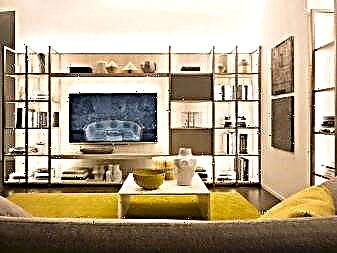

A good technique that is used when you need to hide equipment is sliding panels.
In the same classic style, he will be welcome. Panels moving on the principle of sliding doors, if necessary, will easily hide the TV. Another method is using frames. A TV framed in this way turns into a kind of picture, the content of which changes daily. If you hang pictures or photographs around the TV in harmoniously combining frames, you get an interesting composition, the center of which will be TV.

The now popular stone or brick surfaces will be appropriate in the loft style or in any other modern direction. On a white brick wall, the TV will look especially advantageous. Stone or brick may not be lined with the entire wall, but only the part on which the device is located.
Equally in demand is wall decoration with decorative plaster. It allows you to create an accent zone that attracts glances and is the center of the entire interior. An unusual structure, unique patterns that can be emphasized with paint - all this allows you to create a coating that can perfectly fit into the interior of any style.


With selective finishes, shades are of great importance. They should stand out from the main gamut of the room, but fit into the general style of the interior. The best solution is to choose a color for the walls, which will be 3 tones darker than the main shade. Most often, classic shades are used (cream, chocolate, ivory, black, white). This technique is a good way of zoning the room, which is especially important for a small area. But the shade chosen for the partial decoration of the wall must necessarily be repeated in some decor elements or textile patterns. It should not be a single spot in the interior.


A variety of stickers, posters, collages will help to harmoniously fit the TV into the interior. They can be hung strictly around the perimeter of the TV (the center of the composition), or in a chaotic manner. It is necessary to maintain integrity so that this design does not cause a sense of random, rash piling up of elements, perceived as a whole composition. An interesting result can be obtained by drowning the TV in a niche. It can be framed in contrasting or related colors. For example, a niche made in dark colors looks impressive, underlined by columns of contrasting shades.


Textile, bamboo and wood elements will be appropriate in Japanese, rustic, eco-style. They will create a contrast between the modern manufacturability of TV and their natural naturalness. This is especially true for wood and bamboo. Raw wood furniture, as well as natural colors (olive, sand), living plants in pots, and appropriate decor can support the theme of nature in the interior.


An interesting design of the wall with a TV do-it-yourself watch in the next video.
1. Storage Systems
If the apartment clearly does not have enough storage systems, they can be located on the sides of the TV or around it. A compromise option for those who do not like bulky cabinets and cabinets is a few small wall-mounted and / or floor-mounted storage modules.
The combination of a neat console or cabinet and several open shelves also visually does not make the interior too heavy.
How to choose and install a TV screen
There are not many options for installing the equipment: put on a TV stand or any prepared plane, and also hang on the wall. The second method allows you to save space and enter TV more smoothly in the living room. But it is more difficult to implement - it is necessary to consider several practical points.
Watching TV should be as comfortable as possible. The installation location is ideally determined by the eye level of the beholder, and any deviations from the set position can cause inconvenience. To determine this point, you need to focus on the height of the sofa and adjust the location of objects.
When installing the equipment should take into account the direction of artificial and natural light. Direct rays will create glare on the screen, thereby interfering with viewing. It is also better not to hang the TV on one side with a radiator or other heating devices.
It is important to determine whether the wall can withstand the expected load. True, the weight of modern models can only be critical except for plasterboard partitions. Optionally mount the bracket on a concrete or brick base. In addition, it is necessary to determine the amount of additional equipment in order to worry about the hidden placement of cables.
After solving practical issues, you can begin to develop the design of the wall. A black screen on a plain background without additional objects would be appropriate only in a minimalist interior. In other cases, it is recommended to organize the space in accordance with the requirements of the design project.



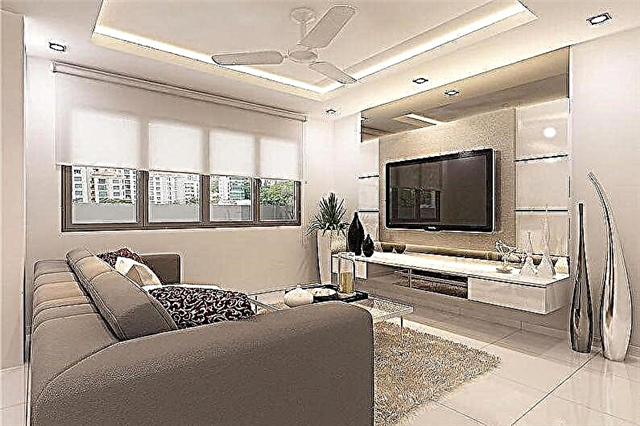
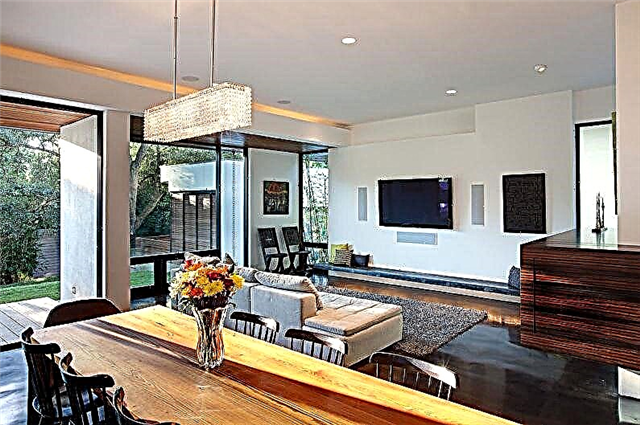

Decoration and wall decor
The partition with technology can be distinguished as the center of the room, facing it differently. Often contrasting colors are chosen for this, not being afraid to overload the room with bright splashes - they will be balanced by the rest of the walls.
As an alternative, you can decorate the cover with a painting, as well as geometric patterns, gently outlining the television screen around the perimeter. This method fits well with contemporary style or pop art.
In addition to colors, the use of other materials for decoration will help to create accents. For example, facing with decorative plaster, stone, cork surface, brickwork naturally looks in modern interiors. Or traditional wallpaper with an ornament typical of classics.
At the same time, using means of artistic expression, it is important to maintain balance, since too bright details can distract attention while watching TV. The screen picture on a dark background is well perceived, especially in the evening. Light surfaces with an interesting texture will help maintain a sense of spaciousness even in a small living room.
A wall with a TV is an area where decorative elements can be concentrated. Wall photos, collections of paintings, small panels or other aesthetic objects built around the center - a TV screen - look harmoniously.
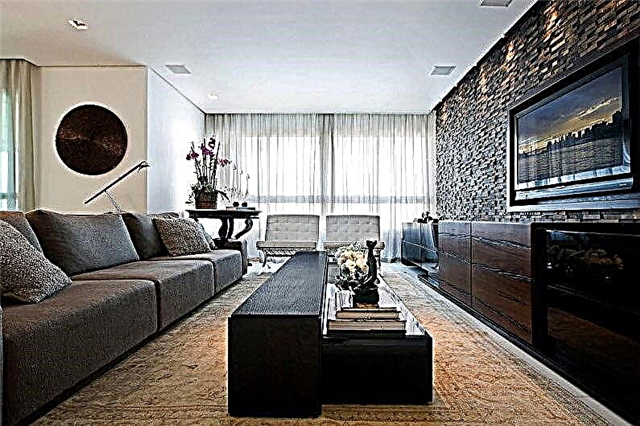
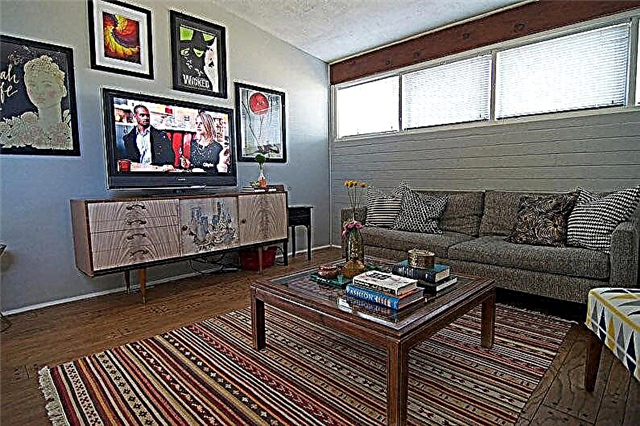


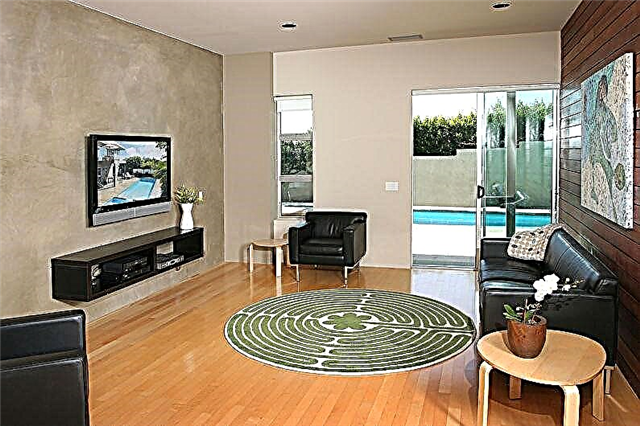



Panels and Partitions
It is not always possible to design a suitable background for a technique that would visually highlight a zone. To solve the problem, you can purchase ready-made panels or make them yourself.
They are a canvas of different materials to choose from: it can be a tree with a beautiful deep texture, as well as a partition covered with leather or fabric.The latest options will bring a little coziness to the interior, but caring for them is more difficult due to the dirt-absorbing texture.
Such panels can cover the entire wall or locally, in accordance with the parameters of the television screen. At the same time, they are suitable for mounting shelves, thereby creating additional storage space. For example, against a background of wood, a set of neutral shades looks beautiful.

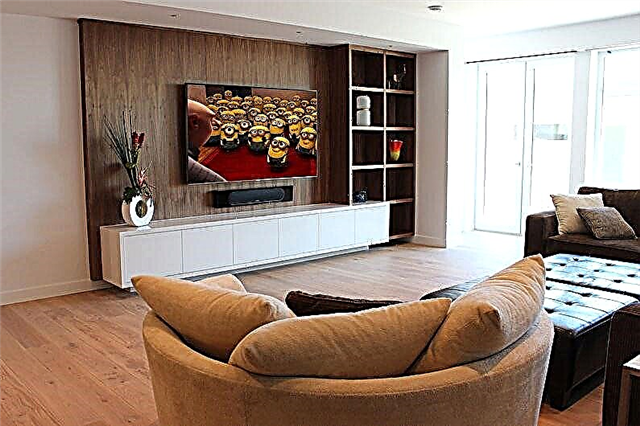

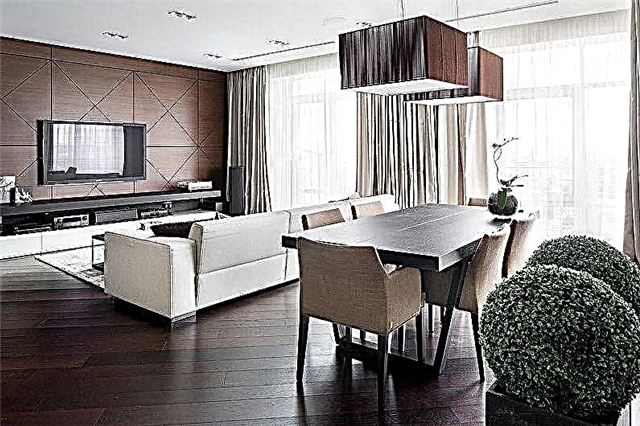

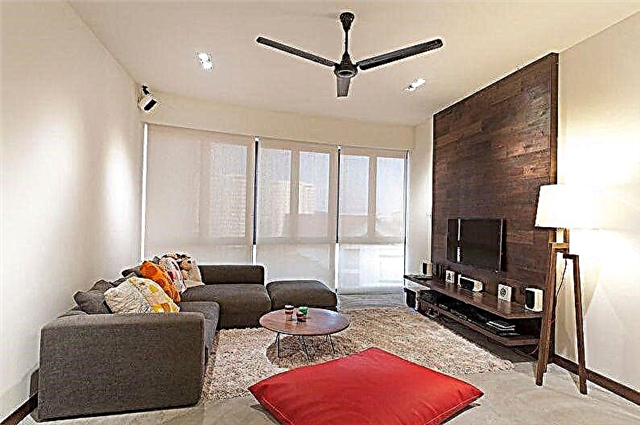
Drywall construction
Drywall products are often used in design because of the universal properties of the material, which is resistant to the negative effects of the environment, but most importantly - it has good ductility. Using it, you can create not only frame structures, but also decorative elements of various shapes.
It is not recommended to hang a television screen on a drywall partition, but it is possible to decorate the area around it with columns or stucco molding, especially if we are talking about an interior in a classic style.
In the framework of modern directions, a monolithic drywall product with a niche for equipment or small shelves with decor and lamps will fit perfectly. It must be remembered that contemporary music gravitates to geometric shapes that you need to focus on when choosing a structure.


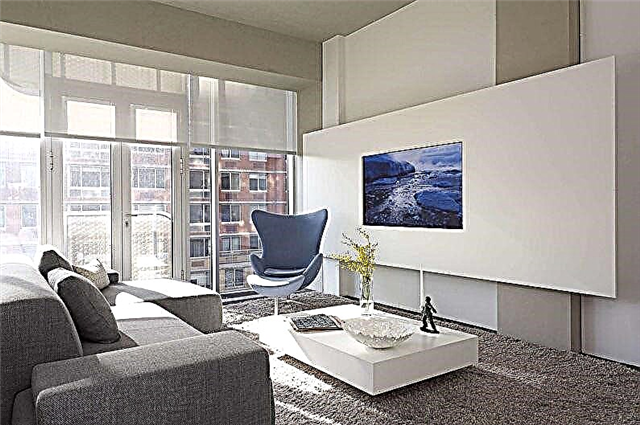

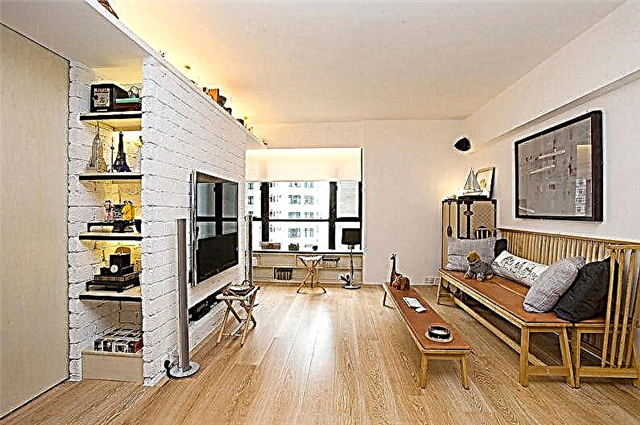
TV in the niche
Today, furniture with built-in appliances or one that involves a niche for its installation is in fashion. This solution allows you to maximize the organization of usable area, storage space and visually hide the plasma.
The selected area can completely match the size of the screen or leave additional space for mounting the backlight with decor.
The niche can be decorated with the help of drywall constructions mentioned above, wooden frames or coatings with mirror tiles. They will create an unusual effect in the living room, doubling it.

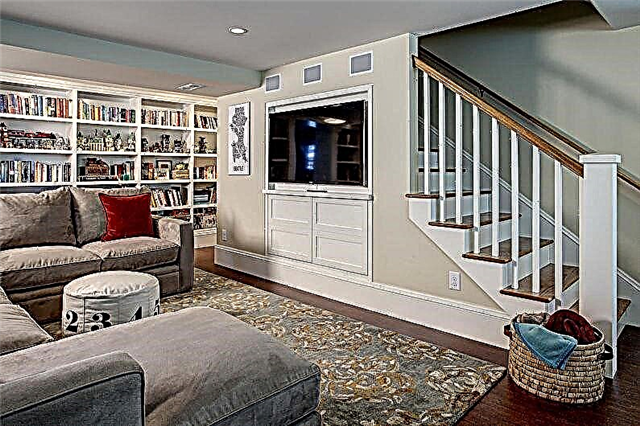

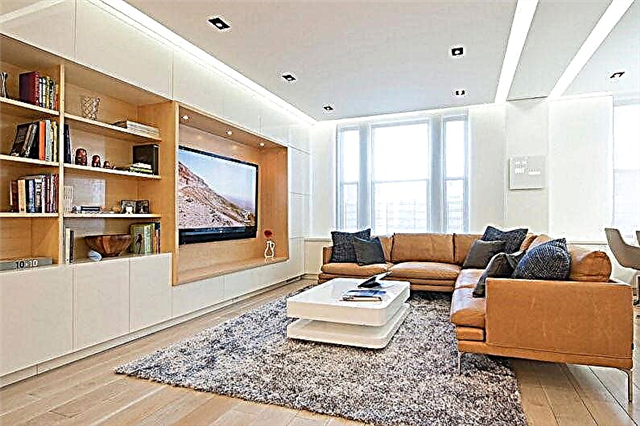
TV in the living room with fireplace
Once, in the pre-electric era, families gathered around the fireplace to keep warm and watch the measured flame dance. The television plays a similar function today, and the simultaneous presence of these two objects causes an imbalance in the room.
There are two ways to solve the problem. Firstly, to divide the living room into two zones - for entertainment by the TV screen and relaxing by the fire, preferably in different parts. In this case, the fireplace can be real, if we are talking about a private house. The technique is recommended to fit into the furniture, distracting attention from its modern look.
Secondly, you can buy an electric fireplace instead of an authentic specimen, and place a plasma above it. Such devices have a modern design, so they fit perfectly into any interior. True, they do not convey the charm of a real fire, but will help diversify the living room.
Keep in mind that the distance between two objects must be at least one meter. Therein lies the minus of the solution, since the screen is above eye level, which affects usability during viewing. You can purchase compact models or adjust the height of the sofa.


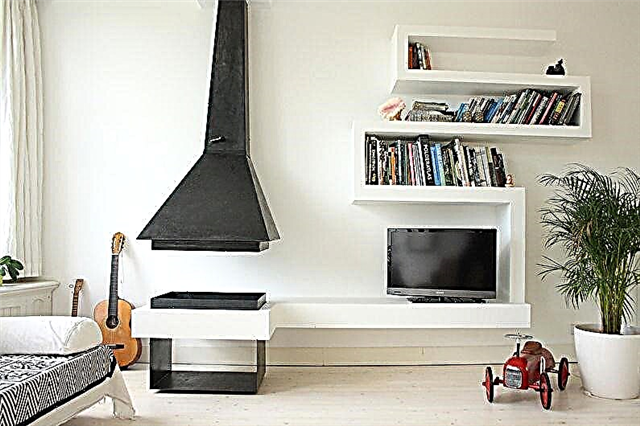
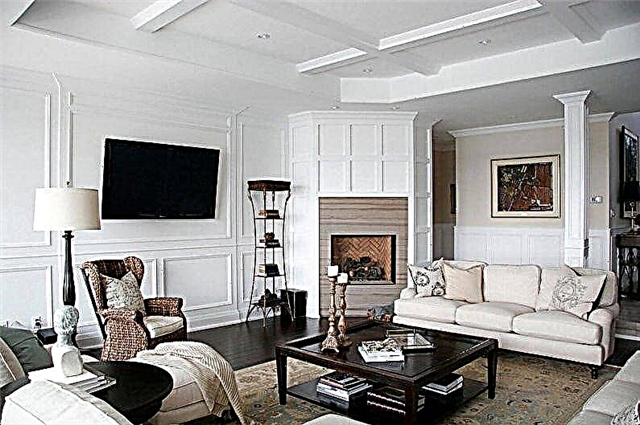
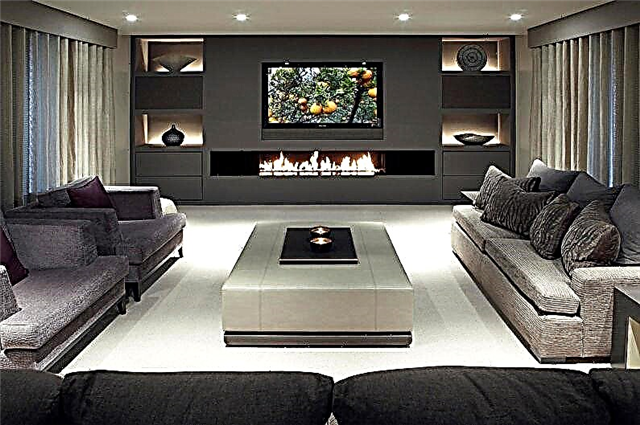
TV and cabinet
Despite the variety of hanging models, do not discard the traditional version with a TV on the furniture plane. It has its own advantages: for example, landing level, mobility and lack of need for installation.
As a support, you can use a wall in spacious rooms or a small TV stand in small dimensions. However, if there is no need for additional storage places, you can stop at a minimalistic option, since restrained subject content is relevant in modern design.
Electronics can be put on any free area of suitable sizes, even a wall shelf. Here it is necessary to build on the principles of comfort and ease of use.
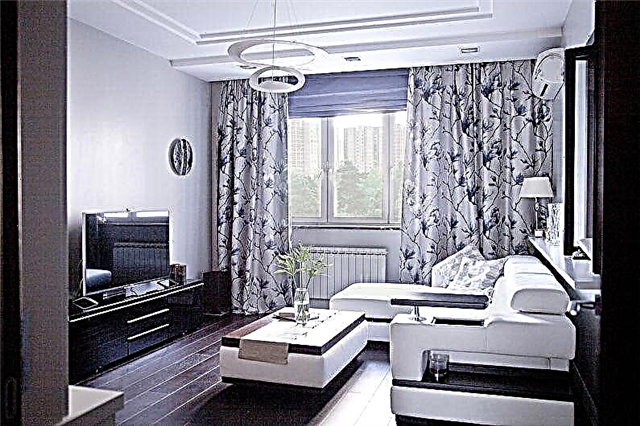
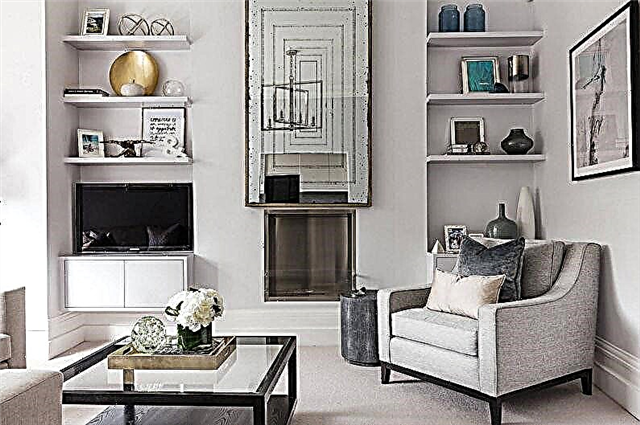



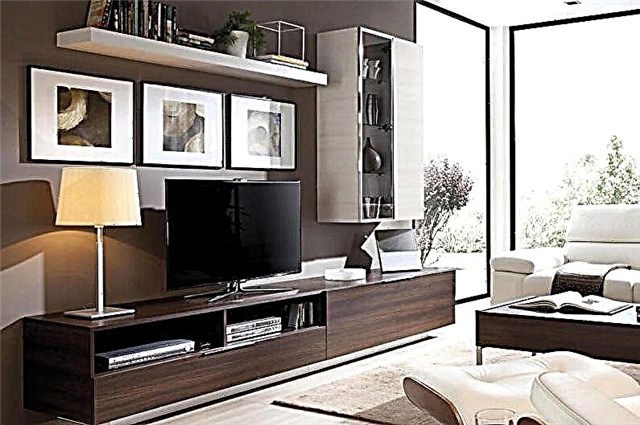
Backlight Options
You can decorate the wall with the TV using the backlight. Despite the fact that direct lighting forms glare on the screen, local sources do not affect the quality of the picture, on the contrary, they help to design the area as aesthetically as possible.
The type of backlight depends on the basis for its installation. Basically, these are cabinets or drywall constructions - they are created by means of an LED strip or spotlights fixed under a pedestal.
Lighting is used not only to highlight the TV, but also other objects located in this area.
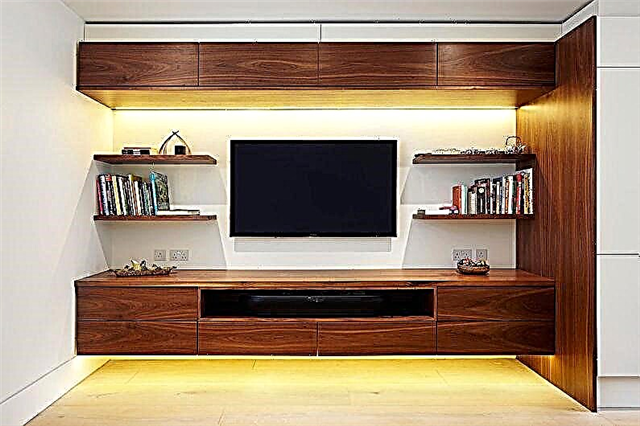



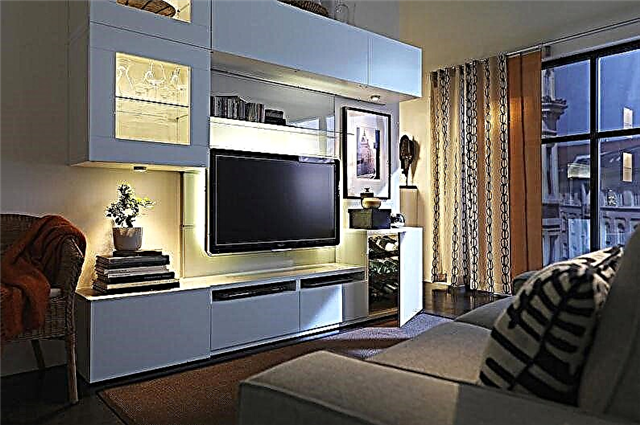
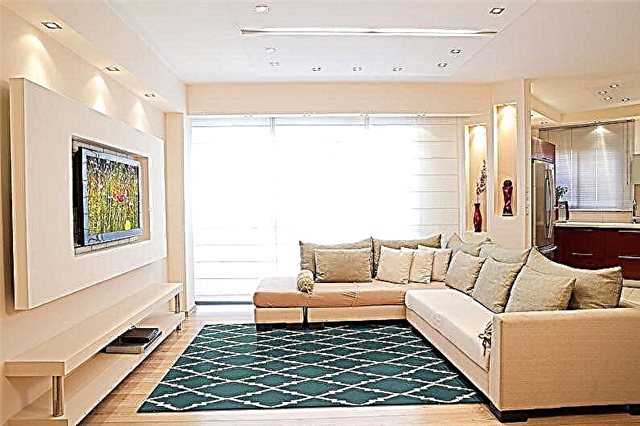
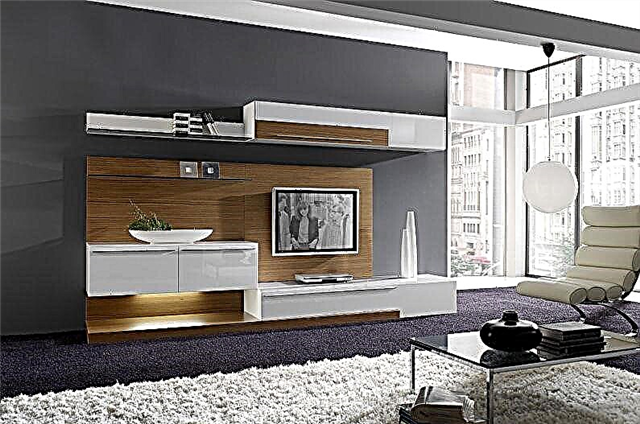
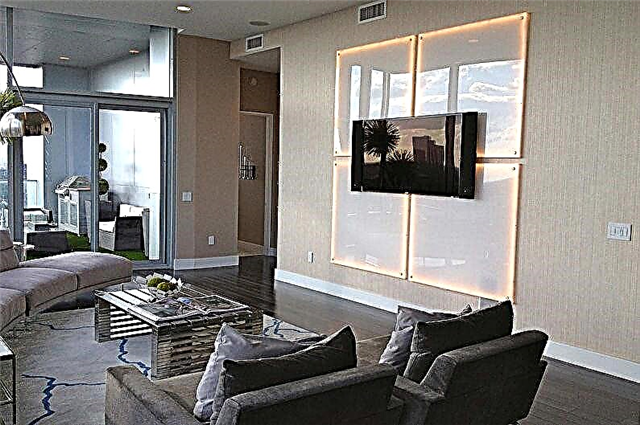
How to hide a TV
This paragraph contradicts all the previous ones, in which the emphasis is on drawing attention to the wall with a television screen. But there are situations when the equipment needs to be hidden from prying eyes and opened only at the time of use. There are several convenient solutions to the problem:
1. Sliding panels. Simple, even construction, behind the facade of which is hiding a TV. To access it, just push the bar. Often combined with a furniture set.
2. Panels with a rotary mechanism. A more elegant option that requires more space to turn the partition with a TV 180 degrees.
3. Mirrors. It can be doors or sliding panels with a mirror coating. A great way to hide the device and visually increase the area due to the reflection effect.
4. The picture. The screen can be placed in a frame, thereby disguising itself as an object of modern art. Or block a niche with a TV canvas, opening if necessary.
Each of these solutions requires special installation skills, but a neat and beautiful result is worth the effort.
1. Experiment with wallpaper
Wallpaper is a magnificent decorative material, which has a huge variety of patterns. To decorate the wall with a TV, you can use the monophonic version with a picture or come up with a wonderful combination of contrasting canvases.
The most expensive are natural wallpapers, which are made from fabric, bamboo or balsa wood. The wall decor with one of these materials will certainly give the room an unusual and sophisticated look.


2. 3D wall with TV
Wall panels have a huge selection of textures, and their voluminous counterparts can fundamentally change the perception of the interior. They are easy to install - no scrupulous surface alignment is required.
Having decorated the wall with the TV with this finishing material, you will get another significant plus - you can install sound insulation between the panels and the wall. Now you can safely enjoy watching TV without worrying about the volume.
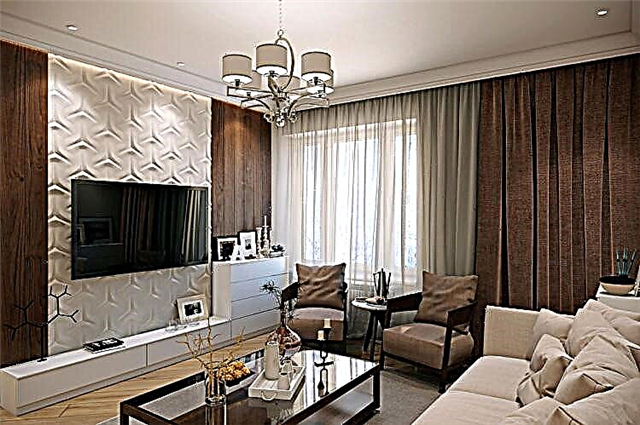

3. Drywall Niche
Drywall is a universal material with which you can not only remove the irregularities of the wall, but also create the most sophisticated structures. Plan a niche of your choice - it can only be a recess in a flat wall or a whole composition of portals and shelves. In the latter version, LED illumination of structural elements will be appropriate.
A wall with a TV niche will not only decorate the room, but also give it additional volume. An interesting solution would be to equip a corner area with a niche in order to save space in a small room.

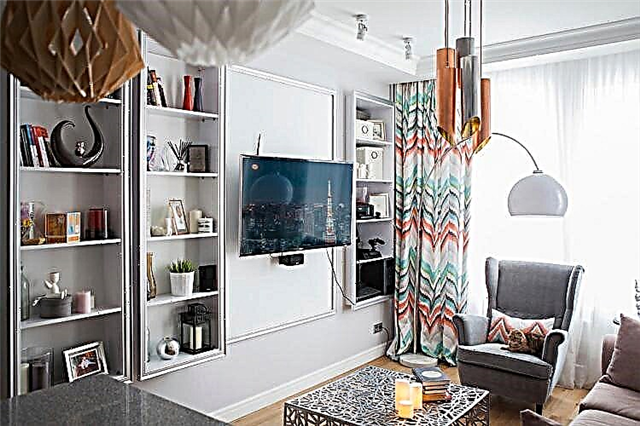
4. Wood panels or laminate
Wooden wall panels have recently become a stylish and convenient "chip" of many interiors. This natural material looks noble, warm and beautiful, having a unique texture donated by mother nature.
They produce material from solid wood or shavings in the form of boards, plates, as well as volumetric parts having a different pattern. By the way, with the help of slatted panels or an ordinary laminate on the wall, you can easily adjust the space of the room - horizontal laying will expand the walls, and vertical - will raise the height.
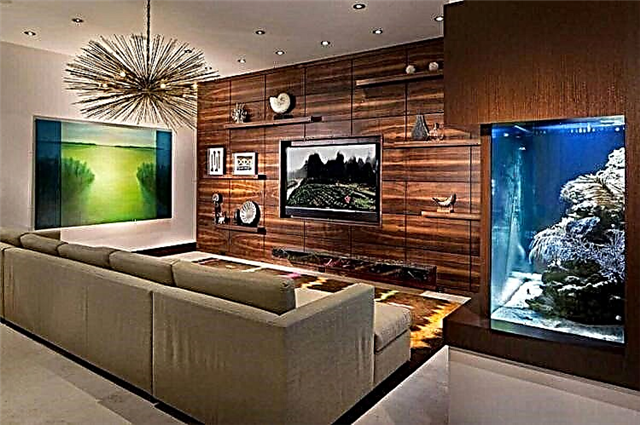

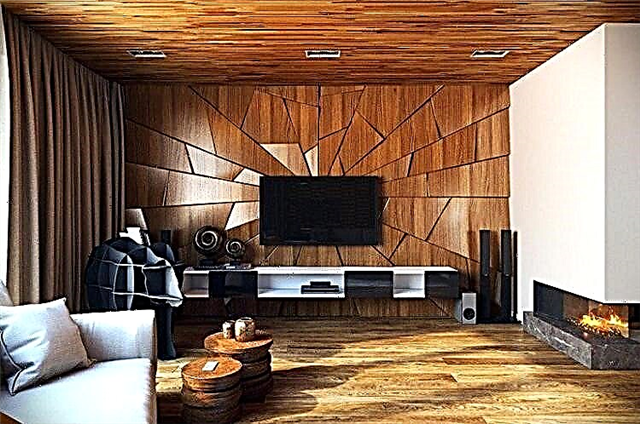
5. Surrounded by shelves
If the wall on which the TV panel is installed is spacious enough, add a few shelves. On them you can place decorative elements, magazines, board games, remote control, etc.
You can also use the installation of bulky modular cabinets. Now the trend is hanging furniture elements with LED backlight.


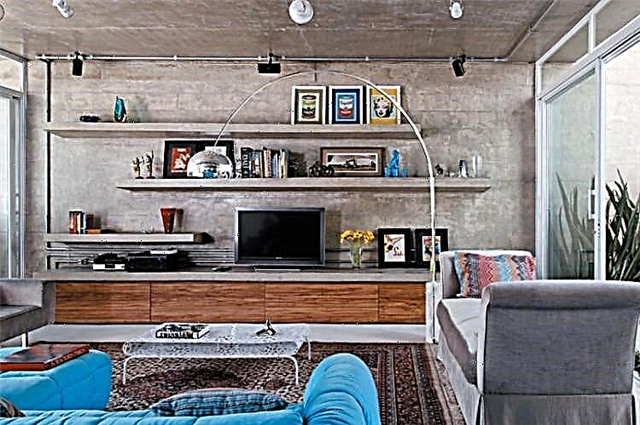
6. Minimalist style
For minimalism, surfaces with drawings, floral prints, monograms and other decorative excesses are not peculiar. The wall with the TV should look concise, riveting the focus on technology.
Here you can take advantage of painting the wall, pasting with plain wallpaper or decorating with wall panels. In order to “domesticate” a strict interior, build a drywall construction with a built-in electric fireplace and a TV. In addition, you can hold hidden lights, and a comfortable evening is provided for you!

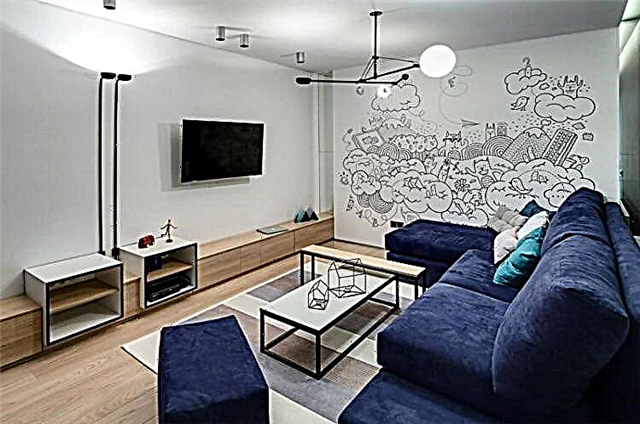
7. TV in a phytowall
Another original idea is to arrange a phytowall with a TV. Such a step will allow you to successfully decorate the interior in eco-notes, and as a bonus get an excellent means of cleaning and humidifying the air.
Do not worry that now cares for plant care will be added - modern “living” walls are equipped with an automatic irrigation system. It remains only to install a few lamps.
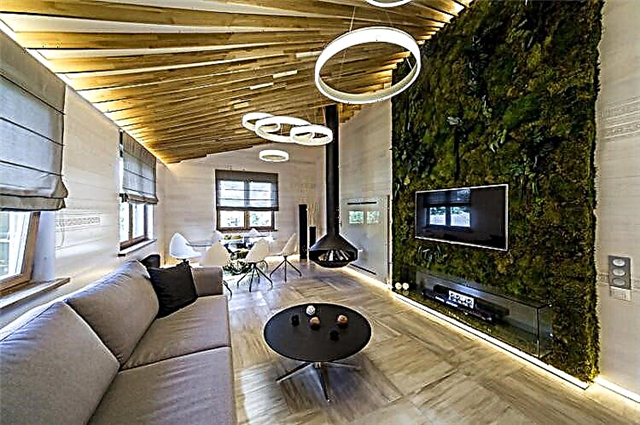

8. Mirror wall
Mirror surfaces in the interior are a great way not only to give originality to the atmosphere, but also to expand the space. Mirrors are able to reflect light fluxes, and therefore the room as a whole will seem lighter.
Install a large mirror panel on the wall with the TV, and the interior will be transformed beyond recognition. You can use small mirrors, for example, to hang several mirror shapes in a chaotic order around the TV.
If you have concerns about the fragility of the material, you can use special mirror vinyl films. Usually, they are produced in roll form or in plates, which allows you to install yourself, without the involvement of specialists.

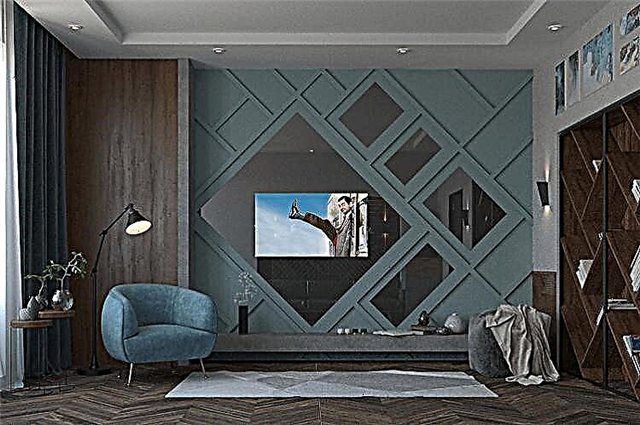
9. Or maybe furniture?
One practical solution is furniture along the wall with an integrated television panel. Thus, you can immediately “kill two birds with one stone”: to provide the apartment with a large storage system, and the TV - a permanent residence.
In a small living room or bedroom, you can hide the TV in the closet behind the sliding doors, which will hide it in case of need.

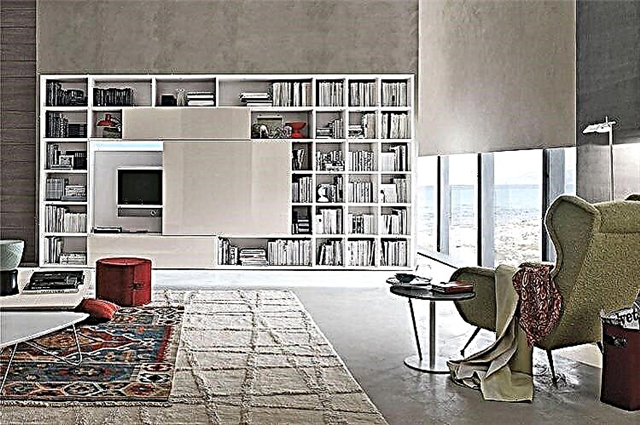
10. Wall of decorative stone
Speaking about the stone in the interior, you need to understand that it can be natural and artificial. The first has a fairly large weight, because its installation is possible in private homes. As for the artificial - this is the most popular material for wall decoration in the apartment today.
A wall with a TV surrounded by stone will turn the recreation area into a warm, cozy corner, despite the fact that the material itself is naturally cold. You do not have to carefully level and grind the wall - volume slabs will hide all the flaws.

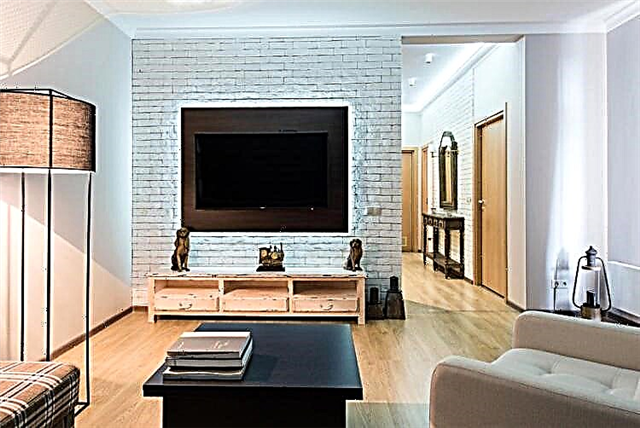
11. TV in a baguette frame
The interior in a classic style cannot be confused with anything. A wealth of decoration, carved furniture from expensive wood, stucco molding, massive chandeliers, gilding - the presence of such pomposity often complicates the installation of the black rectangle of the television panel.
A good solution will be to design a frame that matches the style. The TV on the wall with a fringing in the form of a massive picture frame will look rather harmonious. It can be covered with gilding or patinated, giving a rich historical look.
Polyurethane moldings will come to the rescue. Previously, the wall can be pasted with wallpaper in a classic style with a large, but not bright pattern, so as not to distract attention.
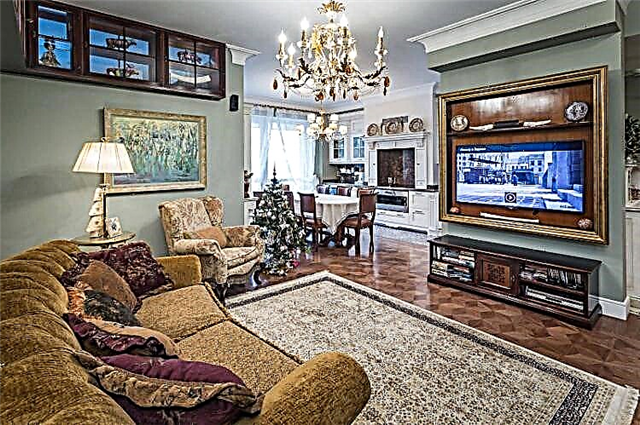
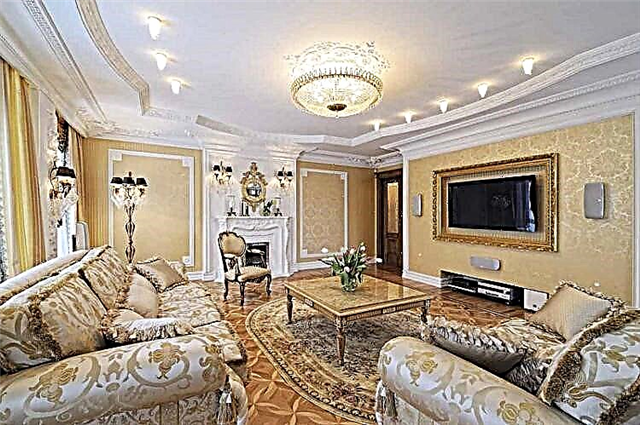

12. Leather wall decoration
Designers increasingly began to pay attention to wall decoration with leather, which perfectly emphasizes the high status of the owners of the house. The material fills the interior with the nobility and respectability inherent in aristocratic mansions.
Leather for wall decoration is available in the form of wallpaper or tile. Since the material is quite expensive, most often they draw up separate sections. One of them may be a wall with a TV, which is most emphasized in the living room.
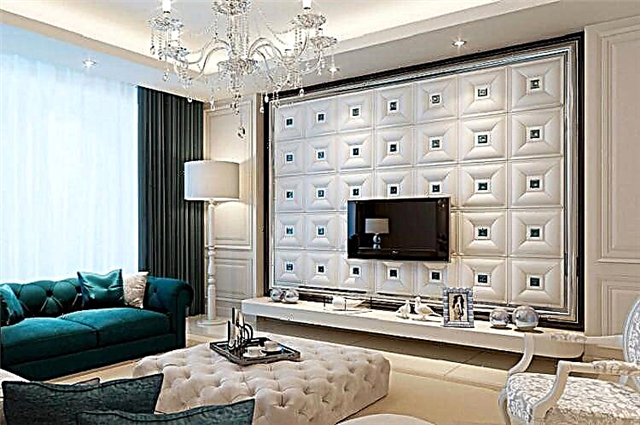

13. Metal wall with a TV
A rare option, but also having the right to exist. Moreover, this solution has a lot of positive advantages. A wall decorated with metal and a plasma panel will look great in high-tech or loft styles.
Such a panel has a reflective effect and is not subject to mechanical stress. The design uses smooth or corrugated steel, metal rags, “stitched” with rivets or the most decorative and, at the same time, expensive material - 3D metal plates.

14. Wallpaper design
You can visually highlight a wall with a TV in the interior using photo wallpaper. Some time ago, their popularity declined, but today they again gain the trust of designers.
There are many models of wallpapers with photo images, including paintings with special effects - stereoscopic or perspective images.


15. Picture gallery
The wall with the TV is dominant in almost any room. The views of households and their guests are most addressed to her. Why not decorate it with the most successful family photographs that will testify to a successful friendly atmosphere?
If you don’t want to flaunt family life, hang paintings or posters on the wall that will be most suitable for the general style.


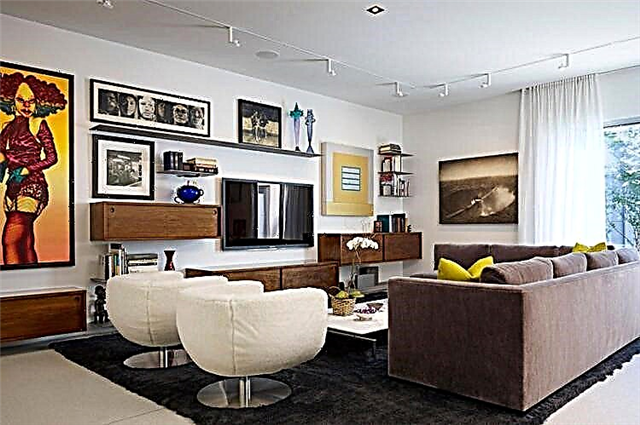
16. TV with fireplace
A fireplace and a TV are fierce rivals today. If earlier families gathered in a close circle or held a celebration near a warm hearth, now everyone is drawn to television panels.
Since an artificial fireplace is installed in apartments, the problem is quite simple to solve - place both objects in one zone. In this case, the TV is installed above the fireplace, and together they will receive an equal share of attention, and you - a luxurious warm interior.


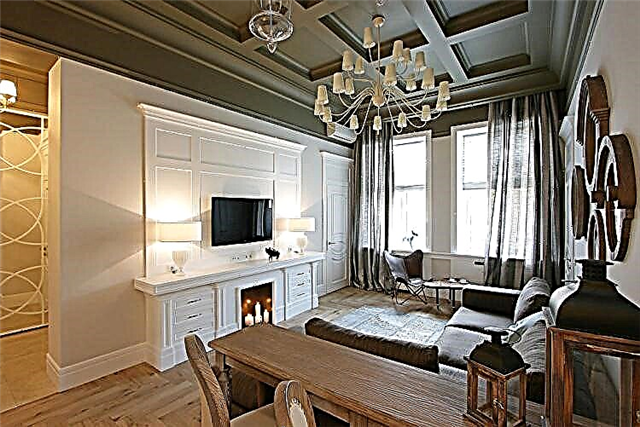
17. "Masking" the TV
The TV on the wall can be hidden with a picture. There are separate companies that specialize in the production of just such paintings.
The essence of the design is that a special mechanism is installed in its upper part, which is able to raise and lower the picture. The TV panel itself is hiding in a niche. Such a picture can be set independently.
If this option does not fit into the modern interior design, you can use sliding panels. Their design can merge with the wall or act as a contrasting accent.

